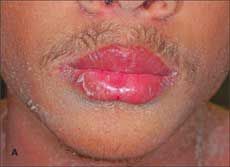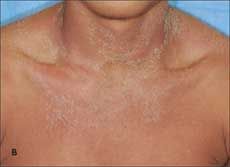Teenager With Fever, Pharyngitis, and Generalized Rash
A previously healthy 16-year-old boy presents for evaluation of a slightly pruritic, nontender, generalized rash.
THE CASE: A previously healthy 16-year-old boy presents for evaluation of a slightly pruritic, nontender, generalized rash. His father reports that the onset of the rash 3 days earlier was associated with tactile fever, pharyngitis, headache, poor appetite, nausea, abdominal pain, and bilateral knee and elbow pain. These symptoms resolved; however, the rash has persisted and the skin of the face, neck, forearms, and upper chest has started to desquamate.

The patient has no sick contacts and does not take any medications. He states that he began using a new shampoo a week earlier; however, the rash does not involve his scalp. He has no history of hospitalizations or surgeries and is up-to-date with his immunizations.
Generalized erythema with desquamation is noted on the lips, neck, axillae, antecubital fossae bilaterally, groin, and lower extremities. The tongue is bright red without exudates. Conjunctivae are slightly injected with no ocular discharge. Cardiac, pulmonary, abdominal, and musculoskeletal findings are normal. There is no lymphadenopathy and no hand or foot edema.
What do you suspect?
•Scarlet fever
•Staphylococcal exanthema
•Viral exanthema
•Drug reaction
(answer on next page)
Answer: Scarlet fever
DISCUSSION: Results of a rapid streptococcal antigen test were negative. Blood work results were significant for neutrophilia and elevated erythrocyte sedimentation rate and C-reactive protein level. Antistreptolysin titer was normal.
The patient was admitted to the hospital because of worsening conjunctival erythema. Intravenous fluids and cefazolin were given. The following day the throat culture results showed light growth of group A β streptococci. The patient was discharged and given a prescription for penicillin-VK.
SCARLET FEVER: A BRIEF OVERVIEW
Scarlet fever is caused by group A β-hemolytic streptococci, which elaborate 1 of the 3 erythrotoxins. The onset is acute and is characterized by fever, vomiting, headache, a toxic appearance, pharyngitis, chills, and occasionally abdominal pain. The rash appears within 12 to 48 hours of the fever onset. The tonsils are hyperemic and edematous and may be covered by gray-white exudates. As the erythrotoxic-mediated exanthema evolves, the tongue may become bright red (“strawberry tongue”) as seen in this patient. The soft palate and uvula are usually reddened and edematous; petechiae may be present on the soft palate.

The exanthema is red, punctate, or finely papular and blanches with pressure. It has a texture of gooseflesh or coarse sandpaper. The rash appears initially in the axillae, groin, and neck; within 24 hours, it becomes generalized. The forehead and cheeks appear flushed, and the area around the mouth is pale. The rash is most intense in the axillae and groin and at pressure sites. Areas of hyperpigmentation that do not blanch with pressure may appear in the deep creases, particularly in the antecubital fossae.

Desquamation begins on the face in fine flakes toward the end of the first week of the illness and continues on the trunk and finally on the hands and feet for up to 6 weeks (Figure). The duration and intensity of desquamation vary with the intensity of the rash.

Penicillin is the drug of choice for the treatment of streptococcal infections. Erythromycin, clindamycin, or first-generation cephalosporins may be used in patients who are allergic to penicillin. Patients with severe scarlet fever are treated parenterally with penicillin.
DIFFERENTIAL DIAGNOSIS
Staphylococcal exanthema. Staphylococcal scalded skin syndrome typically occurs in children younger than 5 years. The rash may be preceded by malaise, fever, irritability, and exquisite skin tenderness. Scarlatiniform erythema develops diffusely and is accentuated in flexural and periorificial areas. The conjunctivae are inflamed. The skin may rapidly acquire a wrinkled appearance, and sterile blisters and erosions may develop diffusely. Circumoral erythema is prominent, as is fissuring around the eyes, mouth, and nose. At this stage, areas of epidermis may separate in response to gentle sheer force (Nikolsky sign). The desquamative phase
begins after 2 to 5 days and healing occurs without scarring within 10 to 14 days. Patients may have pharyngitis, conjunctivitis, and superficial erosions of the lips; however, the intraoral mucosa is spared.
A presumed form of the disease, staphylococcal scarlet fever, presents with a rash that may be indistinguishable from streptococcal disease: diffuse, scarlatiniform, tender erythroderma, which is accentuated in the flexural areas but does not progress to blister formation. The Nikolsky sign may be absent. Strawberry tongue and palatal petechiae are absent. Unlike streptococcal scarlet fever, desquamation begins early in the disease course (by day 2) and is complete within a week. Cultures demonstrate Staphylococcus aureus. Treatment consists of systemic antibiotics, either orally, in cases of localized involvement, or parenterally, with a semisynthetic penicillinase- resistant penicillin. Gentle moistening and cleansing of the skin with Burrow solution or isotonic saline is recommended. An emollient can be applied to alleviate discomfort.
Viral exanthema. Scarlatiniform viral exanthemas may result from infection with a number of different organisms. The disease course may be similar to that of scarlet fever. These exanthemas can be differentiated only by serological studies and by the absence of streptococci in throat and skin cultures. Infections with cytomegalovirus, Epstein-Barr virus, and respiratory viruses may be associated with macular, morbilliform, or urticarial exanthemas, which may be difficult to distinguish from drug rashes. Rashes caused by enteroviruses (which occur year-round but peak in the late summer and fall) can appear as morbilliform, vesicular, petechial, or urticarial exanthemas with target lesions and are usually associated with fever.
Drug reaction. Cutaneous eruptions are the most common manifestations of drug reactions in children. Although the rash often occurs alone, it may be accompanied by fever, arthralgia, general malaise, and other systemic findings. About 50% of these rashes are morbilliform, followed by urticarial, exanthematous, and eczematoid eruptions. However, almost any morphological condition can occur, including exfoliative dermatitis, bullous dermatoses (epidermal necrolysis, erythema multiforme, Stevens-Johnson syndrome), petechial eruptions, acneiform eruptions, lichenoid eruptions, photodermatitis, and fixed drug eruptions.
Typically, after 5 to 10 days of drug therapy, red macules and papules erupt on the extremities and spread centrally to the trunk. The lesions may become confluent; conjunctival and oral mucosal erythema may be prominent.
References:
FOR MORE INFORMATION:
•Behrman RE, Kliegman RM, Jenson HB. Nelson Textbook of Pediatrics. 16th ed. Philadelphia: WB Saunders; 2000:689-692, 803-804.
•Cohen B. Pediatric Dermatology. 2nd ed. Philadelphia: Mosby; 1999:153, 156-161.